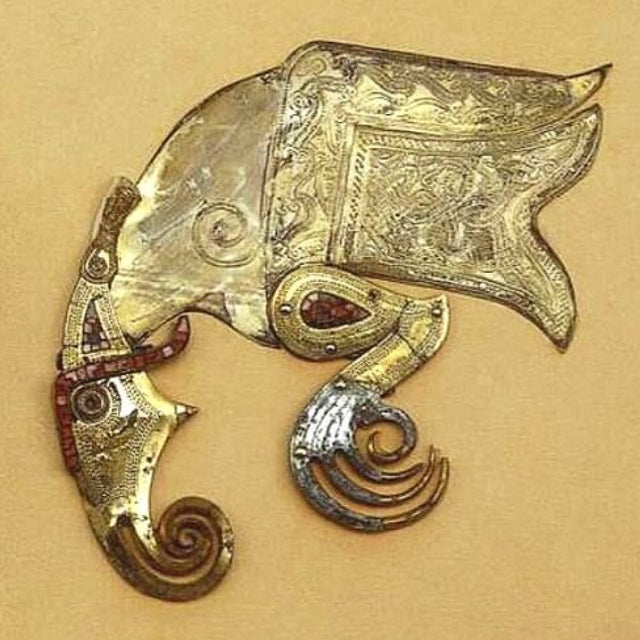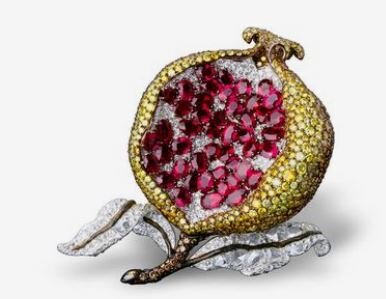Garnet - January’s birthstone

What is bright, refined, resistant, intense and brilliant? The gemstone garnet, or someone born in January’s zodiacal sign Capricorn? It seems a suitable description of both.
YOU SAY GARNET, I SAY GRANADA - WHAT’S IN A NAME?
The emblem of the historic Spanish city Granada is the ‘pomme de Granada’ - pomegranate, cultivated by the city’s C8th Moorish invaders who named their hilly city Ġarnāṭah. Anyone who has cut open a pomegranate is closer to the origin of garnet’s fanciful name. The fruit bursts with lush, chunky, glossy, ruddy seeds, and it’s these that gave us a name for the gem.
GARNET COLOURS
Lke a richly diverse family, garnet naturally occurs in many beautiful colours - red, pink, honey, orange, green and black, sometimes even blue. Technically garnet is a mineral supergroup of diverse varieties, of which only a few are used very often in jewellery. Likewise, there are a multitude of names associated with garnet varieties, which can get confusing. Among these the most well known and popular are: rhodolite with its rose red to raspberry flashes, spessartite with mandarin and cognac tints, tsavorite with intensely zingy yellow green and rare demantoid with its super bright grass-green hue. Garnet even occurs in colour change stones, the hue you see will depend on the light source. For example, a blue gem in cool daylight goes to pinky-violet under artificial yellow light: colour play makes the gem especially desirable.
CARBUNCLE GARNETS
I love a big gemstone in a ring, especially as an oval or cushion cut, and this sort of simple setting really does garnet justice. Historical sources of garnet quite often yielded large rough stones, which were most easily cut en cabochon (with no facets, just smoothly rounded surfaces) in a form called a carbuncle. The word carbuncle thus became synonymous with deep red cabochon garnets. However, garnet is a hard, durable mineral material and takes a good polish, so faceted stones are even more superb.
GARNET GEOLOGY
Mineralogically, the basic ingredients of garnets are the same as Earth’s most abundant constituent elements - oxygen, silicon, calcium and/or aluminium - and are coloured by minor amounts of metal: manganese, iron, magnesium, chromium. Differing types of garnet are formed depending on the pressure and temperature conditions of their growth environment, so garnets are a very useful indicator of Earth’s mantle conditions for researchers. Garnets often form in tightly squeezed, heated and folded schist (aluminium rich, petrified, metamorphosed mud) so these are not so much cold embers, more crystallised beads of rock sweat (4). Microscopic garnet crystals have been found encapsulated in diamond crystals dated over a billion years old (note 5) to give a window into deep time and tectonic processes. Garnets also have a more prosaic use as the crystals in LCD TV & computer screens.
GARNET MYTHS
The myths and etymologies of the words for this gemstone are engaging. The word ‘carbuncle’, an obsolete term for a large, livid, painful boil, comes from the Old French charbuncle, from Latin carbunculus ‘small coal’, from carbo ‘coal, charcoal’. Imagine a round gem, darkly glowing and you might think of cooling coals. Ancient miners believed that the garnets they found embedded in rock strata were crystalised embers from the lamps of beings and spirits of the Underworld. The Viking chiefs took garnets with them to the grave to help light their paths to Valhalla, and imbued their weapons with garnet talismans and inlaid shamanistic birds (3).
During gloomy January, glowing richly hued garnets are just what will warm and guide us through the dark month to the light of early Spring.


Garnet hornblende schist, Ian G Stimpson

Garnet inclusion in diamond, Stephen H Richardson, University of Cape Town

Notes
- Demantiod garnet eternity ring - available to order
- Spessartite garnet cocktail ring - available to order
- For a fascinating summary of garnets in Viking burials as high status grave goods read Gwendolynn de Groote academic thesis https://studenttheses.universiteitleiden.nl/access/item%3A2660086/view
- Rocks of Scotland featured by Ian G Stimpson in Twitter @hypocentre & website https://hypocentre.wordpress.com/2012/01/13/rock-366-day-12-garnet-hornblende-schist/
- Geological Society of London https://blog.geolsoc.org.uk/2019/07/10/the-story-of-thirteen-diamonds-and-their-inclusions/http://collections.vam.ac.uk/item/O74552/ring-unknown/ also read https://deepcarbon.net/feature/pyroxenite-inclusions-transition-zone-diamonds-window-deep-earth
Links for V&A Images
V&A Jewellery Gallery collections Demantoid garnet ring http://collections.vam.ac.uk/item/O74552/ring-unknown/
Rhodolite carbuncle & nephrite plaque http://collections.vam.ac.uk/item/O472418/plaque/
Precious Pomegranate brooch, Michelle Ong for Carnet



